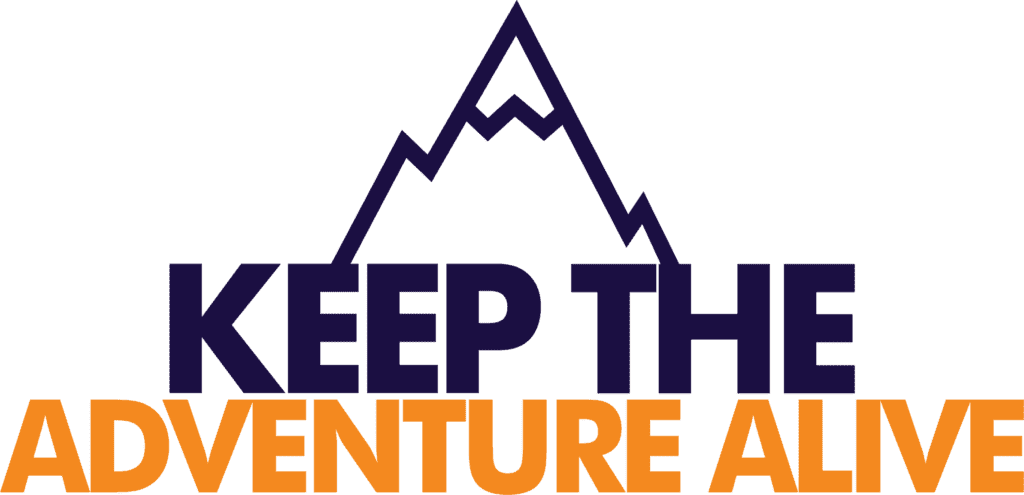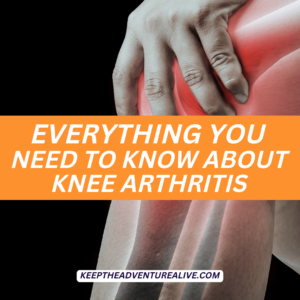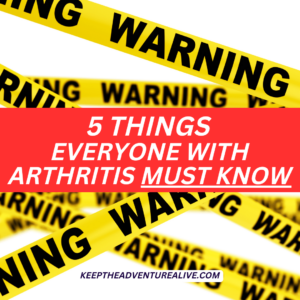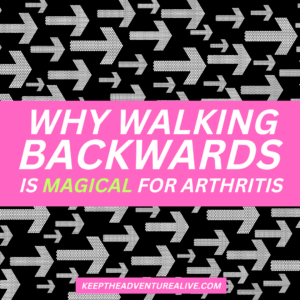Is it good for your joints to exercise with arthritis? Or should you avoid it so you can “save” your joints? In short, the answer is without exercise, you may not be able to find long lasting pain relief. It is one of the most vital components of treating osteoarthritis naturally. If you are looking to avoid surgery, it is crucial that you find ways to strengthen and move your joints in ways that they like. I promise it’s not impossible, even if it feels like it right now!
know you may be sitting there thinking, “well my {insert painful joint(s)} are bone on bone and I don’t have any cartilage left, how can exercise help me?”
OR
“I’ve tried exercise before but it just seems to irritate my joints further or I end up injuring myself…”
It can be scary to exercise when you’re in pain.
Maybe someone has even told you to avoid exercise altogether.
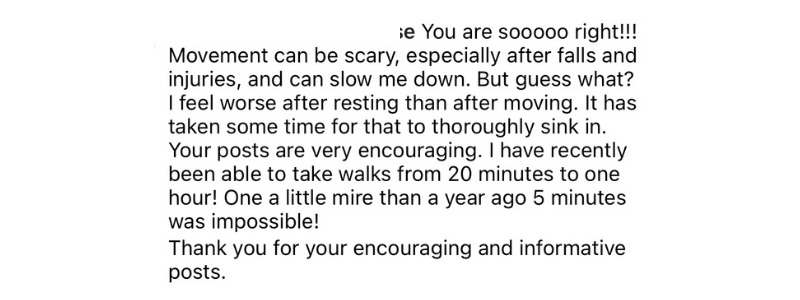
You may think by avoiding exercise, you are “saving your joints” from the wear and tear. But actually, it’s quite the opposite.
Exercise actually is one of the most vital aspects of a treatment plan, especially if you are trying to avoid surgery (learn more about how exercise helps osteoarthritis here).
If you are beginning to feel like you:
- are losing mobility
- have difficulty completing daily tasks
- have gained more weight than you realized
- are losing balance
- have lost confidence
- are scared to move
- stay inside more than going out due to fear of pain
- are a burden to those around you
- are stuck to just deal with pain for the rest of your life
…I want you to know, that you aren’t alone. These thoughts and feelings can be common with osteoarthritis.
But, I want you to know something.
It is possible to regain your strength.
It is possible to feel confident again.
It is possible to regain mobility.
Exercise with arthritis plays a significant role in making these come to life.
It is possible for exercise to feel good. The key is knowing which movements your body and joints like and which they don’t. As a physical therapist who has specialized in helping people with osteoarthritis and treated thousands of people with the condition- I have truly seen the power of exercise firsthand.
So many people have surprised themselves in making activities possible again. Others have found hope and relief for the first time in years. Exercise can truly be powerful when used in the right way.
Below are comments from those who have participated in the FREE 3 Day Arthritis-friendly, Walking Workout Challenge. I created this challenge as a starting point so people could begin to see how powerful exercise can truly be.



One of the most difficult aspects about exercise with arthritis is getting started. It can feel overwhelming when trying to figure out where to start, especially alongside the fear of triggering your pain. That is exactly why I created the 3 Day Walking Workout Challenge to show you exactly where to start.
How to Exercise with Arthritis: 7 Things You Need to Know
Not all exercise is created equal, especially if you have osteoarthritis. Your joints will not like certain movements and they won’t mind others.
The key is finding the right type of exercise because if you don’t, you may actually do more harm than good and we don’t want that!
Here are the 7 considerations I want you to know before you hop into an exercise program:
1. Listen to your body
The phrase “no pain, no gain” does not apply here. Instead, pushing through significant levels of pain can actually drive up both your joint pain and inflammation levels if not careful.
So where should you draw the line?
Discomfort is okay when first starting exercise, trying new movements, and also when it is below a 4/10 on a 0-10 pain scale. Usually in this instance, you can keep going as long as pain doesn’t cross the threshold.
If you are doing an exercise that flares pain significantly (over this 4/10 pain threshold), I like to view it as a way that your joint is trying to communicate with you that whatever you are doing is too much.
Using this scale can help to make exercise much more feasible, instead of constantly guessing whether you are causing more damage or not. Here’s an example a Facebook Community member shared:

2. Find the right modifications
Please understand there are many ways you can exercise with arthritis-finding what feels best to you trumps everything else. That being said, there are a few exercises to certainly prioritize but there are many variations to each exercise!
For example, squats are great to build knee strength to help with knee and hip arthritis as well as even degenerative disc disease. But if squats don’t feel right, you don’t have to do them!
There are 1000s of different ways to do a squat. If you hyperfocus on the only way you know how to do them, you likely will continue to aggravate your joints. If you aren’t sure which modification you should be doing, you can take a look at this video for more examples:
The same modifications exist for other popular movements such as lunges, deadlifts, stairs, push-ups- you name it!
The hardest part can be finding the right modification for you. If you want to take the fast track instead of the trial and error route, the Adventurers for Life membership will set you up for success when it comes to giving you the right modifications as well as prioritizing which movements you need to master.
3. Master bodyweight first
Before you add any weights to an exercise routine, especially with osteoarthritis, it is important you master bodyweight exercises first.
For example, before adding weight to a squat or a deadlift- make sure you can do the movement without weight first. This can ensure you will be set up for success when weight is added.
Strength training is extremely beneficial type of exercise with arthritis and even osteoporosis but does have the potential to lead to more pain if you overload the joint too soon.
It is important to make sure you are progressing through an exercise program by increasing the challenge as your body allows. Once you master the movements at bodyweight, adding weight is vital to help continue to improve muscle strength and joint support.
But the key is making sure you master bodyweight first and avoid progressing too quickly.
One of my favorite tools to begin mastering bodyweight is a set of suspension straps. They offer adequate support without compromising form and can be used at home! Learn more about those here.
I also have some other amazing exercise products and recommendations that I often get questions about so you can get the most out of your exercises in this post.
4. Understand cartilage actually likes exercise
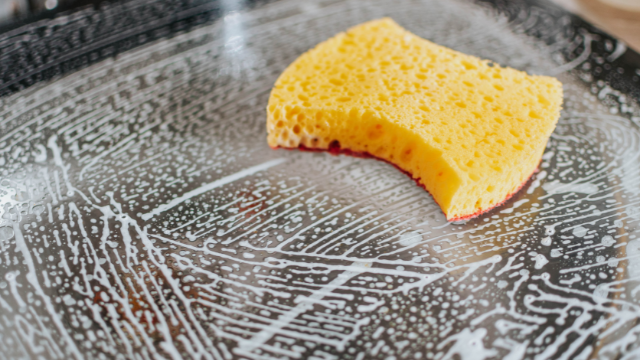
I meet a lot of people who are hesitant to exercise in fear that it will do further damage to cartilage. That the more you move, the worse your joint will become.
I want you to know that your joint is not wearing away further with every step that you take. It actually is quite the opposite.
Your pain is coming from irritation, not from the “wearing away” of the cartilage because cartilage doesn’t have feeling. There are no nerves in your cartilage.
Your cartilage also thrives with movement. Think of it like sponge: when you squeeze it and let go, it is able to reform while absorbing all sorts of new water. Your cartilage is the same way. It gets nutrients by compressing then reforming again.
If you spend too much time sitting, you aren’t allowing as many nutrients to get to the cartilage. This can then lead to joint irritation, much like if you don’t get food you likely will become irritated too! 🙂
5. Don't forget about balance
Balance is incredibly powerful when it comes to healing arthritic joints but it’s one of the most commonly forgot about in typical exercise routines!
If you aren’t able to stand on one leg or stand with one foot in front of the other like on a balance beam, it likely is time to brush up on some balance exercises!
Learn more details about why balance helps osteoarthritic joints and why it needs to be included in exercise with arthritis in this blog post.
Sometimes you may not even know your balance needs work until you try an exercise routine that challenges it!
Inside Adventurers for Life, members are challenging their balance with new movements and improving not only their balance but their confidence. Balance plays such a large role in supporting your joints but also making activities like walking on uneven surfaces like sand possible.
Balance is so much more than being able to stand on one leg. In order to improve balance, you need the right movements to help increase your confidence.




6. A little bit of progress goes a long way
As humans, we can be really hard on ourselves. I’ve noticed that many people feel disappointed when they have to modify an exercise or can’t do as much as they used to be able to do.
These thoughts can lead you to push too hard and overdo it, thus leading to more pain! It is crucial to listen to your body and accomplish what your body is ready for.
Even the smallest of movements can make a big difference, even if it doesn’t feel like it right away! In order to be successful, you have to slowly build confidence.
I have found that you can see so much more success when you take it slow and truly learn what your body is capable of. Trying to speed through a workout you found online may not make your joints feel very good!
With the appropriate guidance, anything is possible. Take it from the wins that members of Adventurers for Life have experienced below:
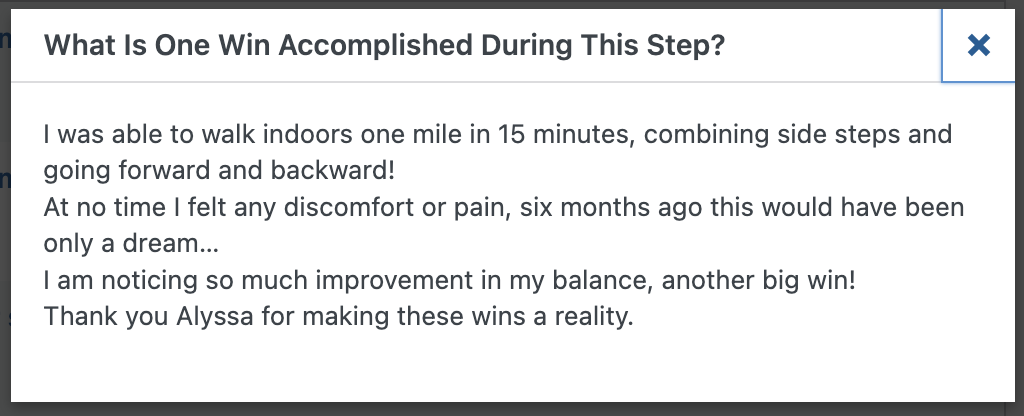
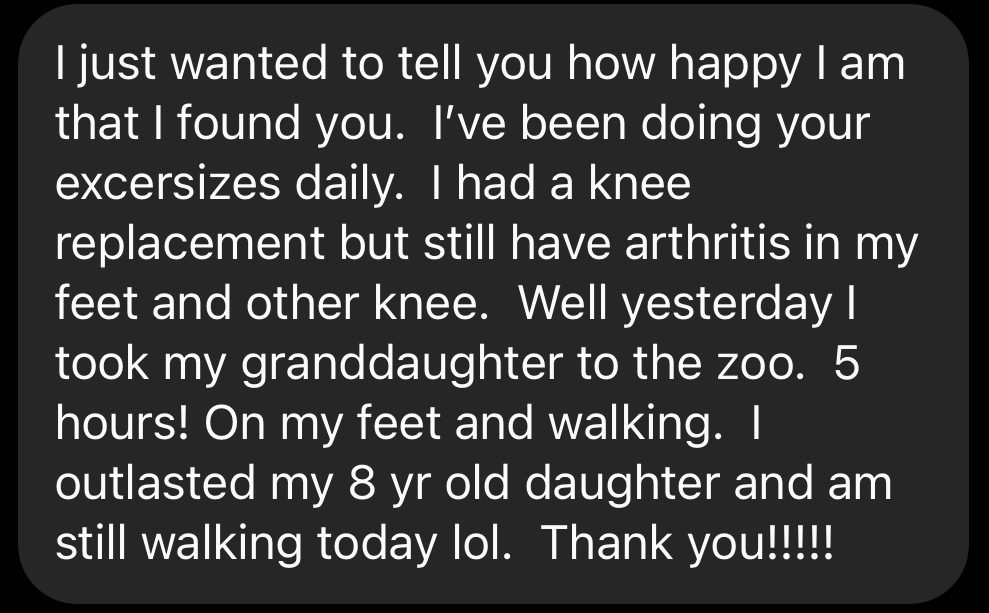

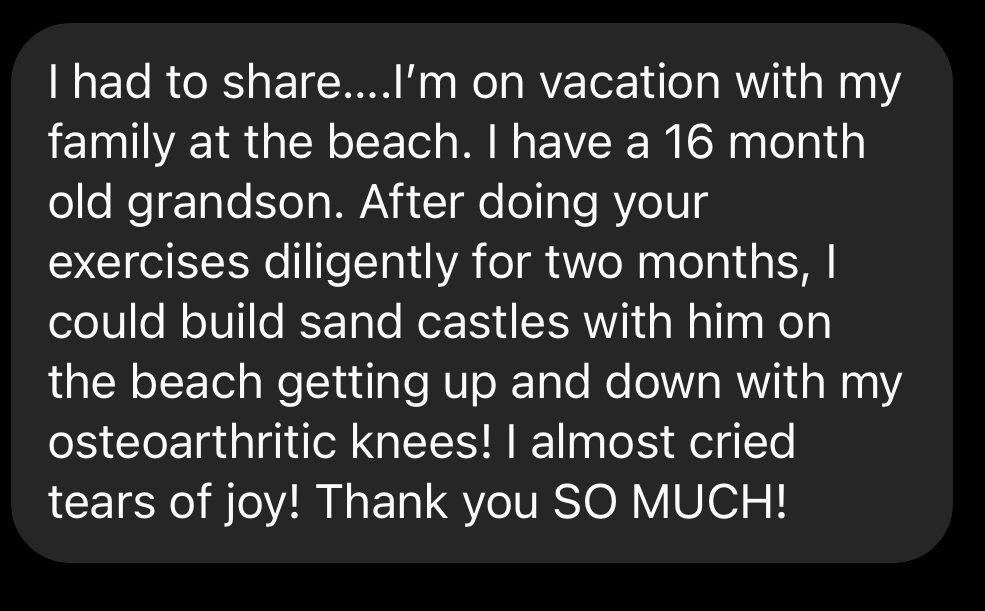
The key is making sure you are on the right path. Without a step-by-step path, you may find yourself dealing with increased pain, fear of movement, and a continued decline of mobility.
Starting slow is not always easy but let me tell you, it’s so worth it. This is why in my signature membership, Adventurers for Life, you will take a test upon entering that will show you where to start based upon your current fitness level. Whether you have difficulty standing for a while, walking for a while, or are looking to improve your strength to unlock more activities- this membership has you covered.
There are so many members who have been able to accomplish more than they ever thought was possible.
This is truly a one stop shop for everything you need to guide you along this arthritis journey- from workouts, to printable articles, to community events and more.
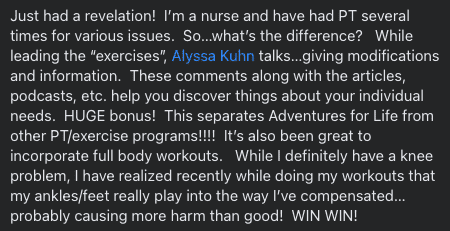
You have nothing to lose and so much to gain.
7. Consistency is key


Okay I saved the best for last. Too many people are out there spreading the word for quick fixes for weight loss and pain relief. This becomes an expectation that all results will happen quickly.
But honestly, the quicker the result happens, the less likely it is to be sustained. It’s the harsh truth…
Think about the last time you tried to start an exercise program or tried to lose weight. Did you find yourself losing motivation or stopping your efforts after a couple of weeks of limited results?
What if I told you that you may have stopped right before a huge breakthrough?
Most of the people I work with start to see long lasting results at 8-10 weeks. Consistency is the key that holds most of the power when it comes to exercise with arthritis and finding true pain relief.
Focusing on the small wins along the way can be truly impactful. The small things you accomplish can be as simple as waking up with a little less stiffness or a less swelling after a walk or even just feeling more energized with just one more hour of sleep.
You have to find a way to be consistent. I recommend working out AT LEAST 3 days a week but increasing to 5 days a week of movement if your joints allow for it. Consistently controlling inflammation in other ways like food and sleep is also a must. Learn more on that here.
Exercise with arthritis: What it can unlock 🔑
Your path to success truly comes with the right guidance, adequate consistency, and not skipping steps.
Where I see most people go wrong is trying to start with exercise that is too intense or not joint friendly or only focusing on exercise and avoiding all other aspects of inflammation control.
You can totally do this. You can overcome your osteoarthritis pain. If you need help getting started, I highly recommend jumping inside the FREE 3 Day Walking Workout Challenge.
If you want to take the fast track and get started right now, head to Adventurers for Life as it has everything you need a sfar as exercise, knowledge, and inflammation control when it comes to osteoarthritis.
You can do this.

If you are looking to regain your active life but are unsure where to start, join the revolutionary membership, Adventurers for Life. This is a step-by-step path that not only will help you find pain relief but will help you unlock adventure. You’ll get workouts, tests to pass to make sure you are on the right track, community events and MORE.
Alyssa Kuhn
Disclaimer: This post is for general informational purposes only. It should not be used to self-diagnose and it is not a substitute for a medical exam, cure, treatment, diagnosis, and prescription or recommendation. It does not create a doctor-patient relationship between Dr. Kuhn and you. You should not make any change in your health regimen or diet before first consulting a physician and obtaining a medical exam, diagnosis, and recommendation. Move Well Age Well, LLC and Dr. Alyssa Kuhn, PT, DPT are not liable or responsible for any advice, course of treatment, diagnosis or any conclusions drawn, services or product you obtain through this video or site.
